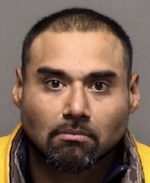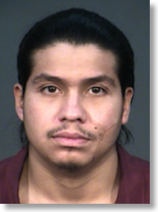Home
A comprehensive resource for safe and responsible laser use
Jail: Over 4 years
US: 51 months for Texas man for aiming at police helicopter
Justin John Shorey, 39
Schertz, Texas, US

On February 17 2019, Shorey knowingly aimed the beam of a laser pointer three times at a San Antonio Police Department helicopter. The light affected the pilot's ability to read his gauges. While the pilot landed safely, he was unable to fly for a week; news reports said he saw spots.
On November 20, 2019 Shorey pleaded guilty to aiming a laser pointer at an aircraft.
He was sentenced on November 9 2020 to 51 months — over four years — in federal prison. In addition, the judge imposed an additional three years supervision after Shorey's release.
Additional details here.
Schertz, Texas, US

On February 17 2019, Shorey knowingly aimed the beam of a laser pointer three times at a San Antonio Police Department helicopter. The light affected the pilot's ability to read his gauges. While the pilot landed safely, he was unable to fly for a week; news reports said he saw spots.
On November 20, 2019 Shorey pleaded guilty to aiming a laser pointer at an aircraft.
He was sentenced on November 9 2020 to 51 months — over four years — in federal prison. In addition, the judge imposed an additional three years supervision after Shorey's release.
Additional details here.
New Zealand: 51 months in jail for aiming a laser into officers' eyes plus other charges
06 Feb 2019 -- Categories: Jail/Prison | Sex: Male
Niki John Gamble-Mackesy, 23
New Zealand (no city given)
On June 3 2018, Niki John Gable-Macksey, 23, aimed a laser pointer at police officers who were conducting a bail check. He deliberately aimed a green "high-powered" laser pointer [likely over the 1 milliwatt New Zealand limit] directly into the officers' eyes.
They felt "immediate discomfort and a burning sensation in their eyes" according to the police report. One of the officers had pain and headaches for the next two days, and was seen by an optometrist. There was no permanent injury to either officer.
On January 30 2019 Gamble-Mackesy was sentenced in Hamilton District Court to four years, three months in jail, and was also ordered not to drive for two years. Charges against him included injuring with intent to injure and threatening to kill (strangling his domestic partner on May 26 2018, and attacking her again on June 8), obstructing the course of justice, dangerous driving, driving while disqualified, failing to stop for police, and two charges of committing an act of criminal nuisance.
The judge's sentencing instructions listed the number of months of imprisonment for various charges:
1) Attempting to pervert the course of justice, 51 months (4 years, 3 months)
2) Disqualified driving, nine months
3) Dangerous driving, two months
4) Failing to stop, six months
5) Injuring with intent to injure, nine months
6) Criminal nuisance (shining a laser at police officers), nine months
7) Threatening to kill, nine months
8) Willfully attempting to pervert the course of justice (separate from #1), nine months.
The prison terms were to be served concurrently, not consecutively, for a total of 51 months of imprisonment.
The above helps show how the judge weighed the relative seriousness of the laser charge, compared with the other charges.
From Stuff.co.nz. Thank you to Yung Chun-fai for providing the text of the sentencing report.
New Zealand (no city given)
On June 3 2018, Niki John Gable-Macksey, 23, aimed a laser pointer at police officers who were conducting a bail check. He deliberately aimed a green "high-powered" laser pointer [likely over the 1 milliwatt New Zealand limit] directly into the officers' eyes.
They felt "immediate discomfort and a burning sensation in their eyes" according to the police report. One of the officers had pain and headaches for the next two days, and was seen by an optometrist. There was no permanent injury to either officer.
On January 30 2019 Gamble-Mackesy was sentenced in Hamilton District Court to four years, three months in jail, and was also ordered not to drive for two years. Charges against him included injuring with intent to injure and threatening to kill (strangling his domestic partner on May 26 2018, and attacking her again on June 8), obstructing the course of justice, dangerous driving, driving while disqualified, failing to stop for police, and two charges of committing an act of criminal nuisance.
The judge's sentencing instructions listed the number of months of imprisonment for various charges:
1) Attempting to pervert the course of justice, 51 months (4 years, 3 months)
2) Disqualified driving, nine months
3) Dangerous driving, two months
4) Failing to stop, six months
5) Injuring with intent to injure, nine months
6) Criminal nuisance (shining a laser at police officers), nine months
7) Threatening to kill, nine months
8) Willfully attempting to pervert the course of justice (separate from #1), nine months.
The prison terms were to be served concurrently, not consecutively, for a total of 51 months of imprisonment.
The above helps show how the judge weighed the relative seriousness of the laser charge, compared with the other charges.
From Stuff.co.nz. Thank you to Yung Chun-fai for providing the text of the sentencing report.
US: UPDATED: 14 -- no, 5 -- years for California man, due in part to past criminal record (overturned June 2015, upheld Nov. 2016)
Sergio Patrick Rodriguez, 26
Clovis, California, US

In the summer of 2012, Rodriguez and his then-girlfriend, Jennifer Lorraine Coleman, 23, were arrested for repeatedly aiming a green laser at a Fresno Police Department helicopter. It had been called out to investigate an earlier illumination of a children’s hospital medical helicopter. On December 20 2013, Rodriguez was found guilty of interfering with an aircraft (penalty up to 20 years in prison) and of aiming a laser pointer at an aircraft (penalty up to 5 years in prison). Coleman was also found guilty of aiming a laser pointer. On March 10 2014, Rodriguez was sentenced to 14 years in prison. On May 12 2014, Coleman was sentenced to two years in prison, to be followed by three years of supervised release.
As of March 2014, this is by far the longest sentence anywhere in the world for a laser/aircraft incident (see here for sentences of 37-48 months and here for sentences over 4 years). Rodriguez’s extensive past criminal record was a key factor helping to increase the length of the sentence; the judge called him a “walking crime spree.”
UPDATED June 24 2015: The 14-year sentence was overturned by a three-judge panel of the U.S. Ninth Circuit Court of Appeals.
The judges did uphold Rodriguez’s conviction for aiming a laser pointer at a helicopter, saying this conviction “is designed for knuckleheads like him.” This conviction carried a 5-year sentence.
But they overturned Rodriguez’s conviction — and his subsequent 14-year sentence — for willfully attempting to interfere with the safe operation of an aircraft in reckless disregard for human safety. The court noted that the second conviction "is designed for both the Osama bin Ladens of the world - people trying to bring down a plane, intending to cause harm - and those who are aware that their actions are dangerous and could harm others, but just don't care…. The failure to recognize this distinction is to fail to appreciate that Congress saw fit to create two different crimes, one more serious than the other, for two different types of offenders.”
Judge Barry Silverman, writing for the panel, said that Rodriguez's intentionally shining the laser at the helicopter "is not, in and of itself, sufficient to allow a rational factfinder to conclude that Rodriguez acted with a reckless disregard for the safety of human life.” Silverman also wrote that “….the evidence showed that he was attempting to see how far his laser would go at night – a stupid thing to do, yes, but there is no evidence that he was trying to interfere with the pilot.”
UPDATED November 4 2016: Rodriguez appealed the June 2015 5-year sentence. On October 17 2016, the U.S. Ninth Circuit Court of Appeals upheld the 5-year sentence. In an unpublished, unanimous opinion, a three-judge panel found the sentence was reasonable, even though advisory guidelines call for a sentence of only 21 to 27 months (1.75 to 2.25 years).
This was due to a number of factors: 1) “Rodriguez increased the dangerousness of the offense by striking the helicopter six or seven times,”, 2) minor children were involved, 3) he had a criminal history including gang involvement and 4) he was on probation when the laser illuminations occurred. From Ars Technica, Pasadena News Now and Courthouse News Service
Clovis, California, US

In the summer of 2012, Rodriguez and his then-girlfriend, Jennifer Lorraine Coleman, 23, were arrested for repeatedly aiming a green laser at a Fresno Police Department helicopter. It had been called out to investigate an earlier illumination of a children’s hospital medical helicopter. On December 20 2013, Rodriguez was found guilty of interfering with an aircraft (penalty up to 20 years in prison) and of aiming a laser pointer at an aircraft (penalty up to 5 years in prison). Coleman was also found guilty of aiming a laser pointer. On March 10 2014, Rodriguez was sentenced to 14 years in prison. On May 12 2014, Coleman was sentenced to two years in prison, to be followed by three years of supervised release.
As of March 2014, this is by far the longest sentence anywhere in the world for a laser/aircraft incident (see here for sentences of 37-48 months and here for sentences over 4 years). Rodriguez’s extensive past criminal record was a key factor helping to increase the length of the sentence; the judge called him a “walking crime spree.”
UPDATED June 24 2015: The 14-year sentence was overturned by a three-judge panel of the U.S. Ninth Circuit Court of Appeals.
The judges did uphold Rodriguez’s conviction for aiming a laser pointer at a helicopter, saying this conviction “is designed for knuckleheads like him.” This conviction carried a 5-year sentence.
But they overturned Rodriguez’s conviction — and his subsequent 14-year sentence — for willfully attempting to interfere with the safe operation of an aircraft in reckless disregard for human safety. The court noted that the second conviction "is designed for both the Osama bin Ladens of the world - people trying to bring down a plane, intending to cause harm - and those who are aware that their actions are dangerous and could harm others, but just don't care…. The failure to recognize this distinction is to fail to appreciate that Congress saw fit to create two different crimes, one more serious than the other, for two different types of offenders.”
Judge Barry Silverman, writing for the panel, said that Rodriguez's intentionally shining the laser at the helicopter "is not, in and of itself, sufficient to allow a rational factfinder to conclude that Rodriguez acted with a reckless disregard for the safety of human life.” Silverman also wrote that “….the evidence showed that he was attempting to see how far his laser would go at night – a stupid thing to do, yes, but there is no evidence that he was trying to interfere with the pilot.”
UPDATED November 4 2016: Rodriguez appealed the June 2015 5-year sentence. On October 17 2016, the U.S. Ninth Circuit Court of Appeals upheld the 5-year sentence. In an unpublished, unanimous opinion, a three-judge panel found the sentence was reasonable, even though advisory guidelines call for a sentence of only 21 to 27 months (1.75 to 2.25 years).
This was due to a number of factors: 1) “Rodriguez increased the dangerousness of the offense by striking the helicopter six or seven times,”, 2) minor children were involved, 3) he had a criminal history including gang involvement and 4) he was on probation when the laser illuminations occurred. From Ars Technica, Pasadena News Now and Courthouse News Service